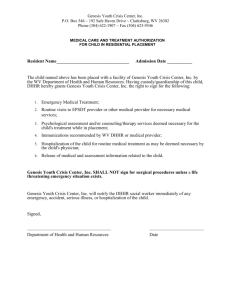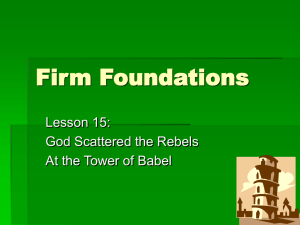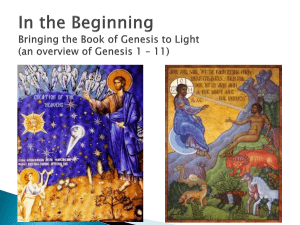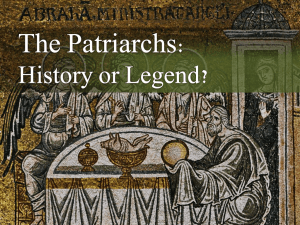Genesis 1-11 overview - St Nicholas Church, Allestree
advertisement
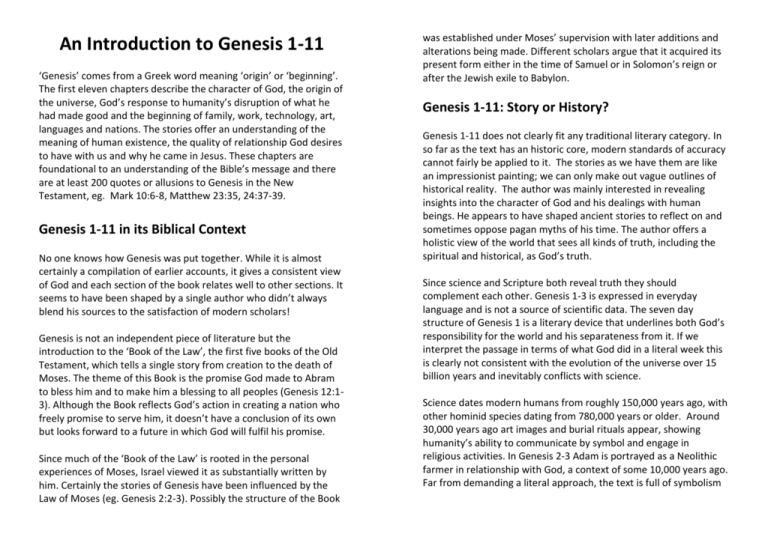
An Introduction to Genesis 1-11 ‘Genesis’ comes from a Greek word meaning ‘origin’ or ‘beginning’. The first eleven chapters describe the character of God, the origin of the universe, God’s response to humanity’s disruption of what he had made good and the beginning of family, work, technology, art, languages and nations. The stories offer an understanding of the meaning of human existence, the quality of relationship God desires to have with us and why he came in Jesus. These chapters are foundational to an understanding of the Bible’s message and there are at least 200 quotes or allusions to Genesis in the New Testament, eg. Mark 10:6-8, Matthew 23:35, 24:37-39. Genesis 1-11 in its Biblical Context No one knows how Genesis was put together. While it is almost certainly a compilation of earlier accounts, it gives a consistent view of God and each section of the book relates well to other sections. It seems to have been shaped by a single author who didn’t always blend his sources to the satisfaction of modern scholars! Genesis is not an independent piece of literature but the introduction to the ‘Book of the Law’, the first five books of the Old Testament, which tells a single story from creation to the death of Moses. The theme of this Book is the promise God made to Abram to bless him and to make him a blessing to all peoples (Genesis 12:13). Although the Book reflects God’s action in creating a nation who freely promise to serve him, it doesn’t have a conclusion of its own but looks forward to a future in which God will fulfil his promise. Since much of the ‘Book of the Law’ is rooted in the personal experiences of Moses, Israel viewed it as substantially written by him. Certainly the stories of Genesis have been influenced by the Law of Moses (eg. Genesis 2:2-3). Possibly the structure of the Book was established under Moses’ supervision with later additions and alterations being made. Different scholars argue that it acquired its present form either in the time of Samuel or in Solomon’s reign or after the Jewish exile to Babylon. Genesis 1-11: Story or History? Genesis 1-11 does not clearly fit any traditional literary category. In so far as the text has an historic core, modern standards of accuracy cannot fairly be applied to it. The stories as we have them are like an impressionist painting; we can only make out vague outlines of historical reality. The author was mainly interested in revealing insights into the character of God and his dealings with human beings. He appears to have shaped ancient stories to reflect on and sometimes oppose pagan myths of his time. The author offers a holistic view of the world that sees all kinds of truth, including the spiritual and historical, as God’s truth. Since science and Scripture both reveal truth they should complement each other. Genesis 1-3 is expressed in everyday language and is not a source of scientific data. The seven day structure of Genesis 1 is a literary device that underlines both God’s responsibility for the world and his separateness from it. If we interpret the passage in terms of what God did in a literal week this is clearly not consistent with the evolution of the universe over 15 billion years and inevitably conflicts with science. Science dates modern humans from roughly 150,000 years ago, with other hominid species dating from 780,000 years or older. Around 30,000 years ago art images and burial rituals appear, showing humanity’s ability to communicate by symbol and engage in religious activities. In Genesis 2-3 Adam is portrayed as a Neolithic farmer in relationship with God, a context of some 10,000 years ago. Far from demanding a literal approach, the text is full of symbolism and is best treated as a truth revealing story about God’s relationship with humanity and how sin has broken it. Although the genealogy in Genesis 5 suggests a historical picture, the fluidity of the Hebrew word ‘adam’ makes it hard to be sure where it is intended as a generic term for humanity and where it is meant to be the name of an historic individual. If we view biblical Adam as the ancestor of all racial groups this fails to explain the genetic and fossil evidence. On the other hand, if we accept the genetic data of an African origin for human beings some 140,000 years ago, could the emergence of the image of God and the presence of sin have happened gradually? On the latter view, God’s creation of a good humanity and human responsibility for the entrance of sin remains historical but not instantaneous. Genesis 2 and 3 will thus be read as metaphorical, indicating in story form why humanity needs salvation. Long before Genesis began to take its current form, stories of creation and a great flood were circulating in the ancient Near East. In the Enuma Elish and Genesis 1 light emerges from a watery chaos, followed by the sky, dry land, heavenly bodies and finally people; after this the creator rested. There are, of course, many differences but even where Genesis 1 most resembles the pagan stories it critiques their assumptions. It is likely that both pagan and biblical stories depend on the same literary ideas. While the former aroused anxiety that the cosmos would collapse back into chaos, the latter stressed that God’s creation is permanent and not dependent on sacrifices to the gods or divine whim. The Story of Genesis 1-11 1. God created a world of light, sky, sea, land, and living things in six days and rested on the seventh day. He made human beings in his image, to reflect his personality and represent him in the world. 2. God placed man and woman in a comfortable garden where they enjoyed food they had not cultivated and communicated with God daily. Adam and Eve were companions, neither being more important than the other, in a committed sexual relationship. 3. Though living contentedly, they were cleverly misled into disobeying a command which, like a good parent, God had given in the best interests of human wellbeing. As a consequence of overstepping their limits, God called them to care for the land outside Eden where they experienced life’s complications including stress, pain and sickness. 4. In a context of broken relationships at multiple levels, Adam’s son Cain murdered his brother Abel though God had promised to accept him if he did what was right. Cain’s descendants built cities, developed agriculture and cultivated arts and technology but violence became more intense. 5. The generations of humans from Adam’s son Seth, who replaced Abel, included people like Enoch who walked faithfully with the Lord. 6-9. God decided that wickedness had grown to such an extent that judgment was the only answer. Yet, even here, God’s purpose is not ultimately destructive. Noah and his family, along with a representative sample of animals, are saved through God’s grace. The world perished but when the flood waters subsided God made a covenant with Noah, pledging his love even through the worst of human wrongdoing. Noah’s episode of drunkenness and the vile behaviour of Noah’s son Ham proved that human perversity still remained. 10. Humanity grew in number through Noah’s sons and spread throughout the Mediterranean, Asia Minor and the Near East. 11. With a single international language and advanced building technology, humanity united to build a tower that would be a gate to heaven. God frustrated their plans by confusing their language. Genesis 1-11 ends with the genealogy of Noah’s son Shem, to whom Abraham traced his lineage.
